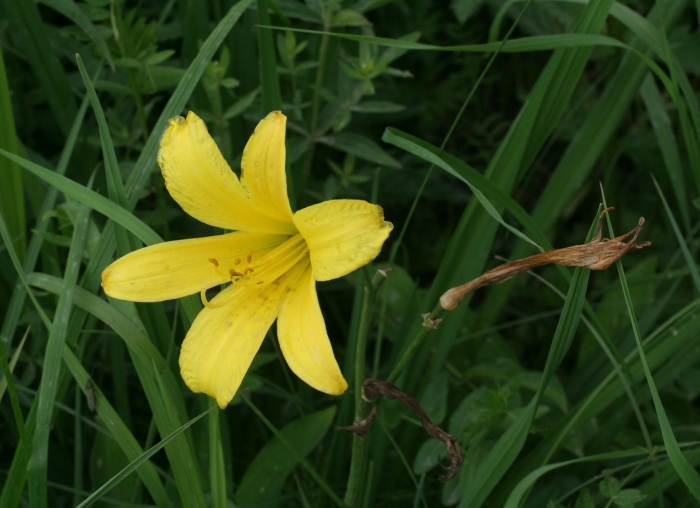Dwarf Daylily
(Hemerocallis minor)
Dwarf Daylily (Hemerocallis minor)
/
/

Oleg Kosterin
CC BY 4.0
Image By:
Oleg Kosterin
Recorded By:
Copyright:
CC BY 4.0
Copyright Notice:
Photo by: Oleg Kosterin | License Type: CC BY 4.0 | License URL: http://creativecommons.org/licenses/by/4.0/ | Rights Holder: Oleg Kosterin | Publisher: iNaturalist | Date Created: 2020-06-14T13:02:54-07:00 |























Estimated Native Range
Summary
Hemerocallis minor, commonly known as Dwarf Daylily, is a perennial herb native to grasslands, slopes, and forest margins in northern Asia, including Siberia and China. It is a compact plant, typically growing up to 2 feet tall with a similar spread. Dwarf Daylily features grass-like foliage and produces bright yellow, trumpet-shaped flowers that bloom in early to mid-summer. Each flower lasts just one day, but the plant produces many buds, ensuring a long flowering period. The flowers are moderately showy and attract pollinators such as bees and butterflies.
Dwarf Daylily is valued for its low maintenance, drought tolerance, and ability to thrive in a variety of soil conditions, although it prefers well-drained loamy soils. It is often used in border plantings, rock gardens, and as ground cover. In addition to its ornamental use, Hemerocallis minor is also cultivated for its edible flowers and tubers, which are consumed in traditional Chinese cuisine. It requires full sun to partial shade and moderate watering, with increased moisture during the growing season. While generally disease-resistant, it can be susceptible to daylily rust and should be monitored for pests like aphids and thrips. This species is not known for being invasive and does not have aggressive roots, making it a safe choice for most gardens.CC BY-SA 4.0
Dwarf Daylily is valued for its low maintenance, drought tolerance, and ability to thrive in a variety of soil conditions, although it prefers well-drained loamy soils. It is often used in border plantings, rock gardens, and as ground cover. In addition to its ornamental use, Hemerocallis minor is also cultivated for its edible flowers and tubers, which are consumed in traditional Chinese cuisine. It requires full sun to partial shade and moderate watering, with increased moisture during the growing season. While generally disease-resistant, it can be susceptible to daylily rust and should be monitored for pests like aphids and thrips. This species is not known for being invasive and does not have aggressive roots, making it a safe choice for most gardens.CC BY-SA 4.0
Plant Description
- Plant Type: Herb
- Height: 1-2 feet
- Width: 0.75-1 feet
- Growth Rate: Moderate
- Flower Color: Yellow
- Flowering Season: Spring, Summer, Fall
- Leaf Retention: Deciduous
Growth Requirements
- Sun: Full Sun
- Water: Medium
- Drainage: Medium, Slow
Common Uses
Border Plant, Butterfly Garden, Deer Resistant, Drought Tolerant, Groundcover, Low Maintenance, Potted Plant, Street Planting
Natural Habitat
Grasslands, slopes, and forest margins in northern Asia
Other Names
Common Names: Dwarf Daylily, Grassleaf Daylily, Dwarf Yellow Day-Lily, Hosoba-Kisuge, Xiao Huang Hua Cai
Scientific Names: , Hemerocallis minor, Hemerocallis flava var. minor, Hemerocallis graminea, Hemerocallis graminifolia, Hemerocallis lilioasphodelus subsp. minor, Hemerocallis lilioasphodelus var. minor, Hemerocallis pumila, Hemerocallis sulphurea,
GBIF Accepted Name: